Enhancing Remote Sensing Water Quality Inversion through Integration of Multisource Spatial Covariates: A Case Study of Hong Kong’s Coastal Nutrient Concentrations
Abstract
:1. Introduction
2. Materials and Methods
2.1. Study Area
2.2. Data Sources and Processing
2.2.1. In Situ Data
2.2.2. Remote Sensing Data
2.2.3. Key Optical Bands
2.2.4. Hydrometeorological Data
2.2.5. Match-Up Analysis
2.3. Model Development
2.3.1. Feature Selection
2.3.2. Hyperparameter Tuning
2.3.3. Machine Learning Model
2.4. Model Evaluation
2.4.1. Data Separation
2.4.2. Algorithm Accuracy Evaluation
2.5. Uncertainty Analysis
2.6. SHAP Model Interpretation
2.7. Spatial-Temporal Distribution Analysis
3. Results
3.1. Model Performance
3.2. Uncertainty Analysis
3.3. Spatial Distribution
3.4. Interannual Trends
3.5. Seasonal Pattern
3.6. Model Interpretation
4. Discussion
4.1. The Problem of Overfitting
4.2. Potential Mechanism
4.3. Limitations and Future Directions
5. Conclusions
Author Contributions
Funding
Data Availability Statement
Acknowledgments
Conflicts of Interest
References
- Creel, L. Ripple Effects: Population and Coastal Regions; Population Reference Bureau: Washington, DC, USA, 2003. [Google Scholar]
- Clark, J.R. Coastal Zone Management Handbook; CRC Press/Lewis Publishers: Boca Raton, FL, USA, 2018. [Google Scholar]
- Kitamori, K.; Manders, T.; Dellink, R.; Tabeau, A. OECD Environmental Outlook to 2050: The Consequences of Inaction; 92641221468; OECD: Paris, France, 2012. [Google Scholar]
- World Health Organization; UNICEF. Meeting the MDG Drinking Water and Sanitation Target: The Urban and Rural Challenge of the Decade; World Health Organization: Geneva, Switzerland; UNICEF: New York, NY, USA, 2006. [Google Scholar]
- Nixon, S. Marine Eutrophication: A Growing International Problem. Ambio 1990, 19, 101. [Google Scholar]
- Bartram, J.; Ballance, R. (Eds.) Water Quality Monitoring: A Practical Guide to the Design and Implementation of Freshwater Quality Studies and Monitoring Programmes; CRC Press: Boca Raton, FL, USA, 1996. [Google Scholar]
- Ritchie, J.C.; Zimba, P.V.; Everitt, J.H. Remote Sensing Techniques to Assess Water Quality. Photogramm. Eng. Remote Sens. 2003, 69, 695–704. [Google Scholar] [CrossRef]
- Mouw, C.B.; Greb, S.; Aurin, D.; DiGiacomo, P.M.; Lee, Z.; Twardowski, M.; Binding, C.; Hu, C.; Ma, R.; Moore, T.; et al. Aquatic Color Radiometry Remote Sensing of Coastal and Inland Waters: Challenges and Recommendations for Future Satellite Missions. Remote Sens. Environ. 2015, 160, 15–30. [Google Scholar] [CrossRef]
- Wong, M.-S.; Lee, K.-H.; Kim, Y.-J.; Nichol, J.E.; Li, Z.; Emerson, N. Modeling of Suspended Solids and Sea Surface Salinity in Hong Kong Using Aqua/MODIS Satellite Images. Korean J. Remote Sens. 2007, 23, 161–169. [Google Scholar]
- Hafeez, S.; Wong, M.S.; Ho, H.C.; Nazeer, M.; Nichol, J.; Abbas, S.; Tang, D.; Lee, K.H.; Pun, L. Comparison of Machine Learning Algorithms for Retrieval of Water Quality Indicators in Case-II Waters: A Case Study of Hong Kong. Remote Sens. 2019, 11, 617. [Google Scholar] [CrossRef]
- Liu, J.; Qiu, Z.; Feng, J.; Wong, K.P.; Tsou, J.Y.; Wang, Y.; Zhang, Y. Monitoring Total Suspended Solids and Chlorophyll-a Concentrations in Turbid Waters: A Case Study of the Pearl River Estuary and Coast Using Machine Learning. Remote Sens. 2023, 15, 5559. [Google Scholar] [CrossRef]
- Dong, L.; Wang, D.; Song, L.; Gong, F.; Chen, S.; Huang, J.; He, X. Monitoring Dissolved Oxygen Concentrations in the Coastal Waters of Zhejiang Using Landsat-8/9 Imagery. Remote Sens. 2024, 16, 1951. [Google Scholar] [CrossRef]
- Gholizadeh, M.H.; Melesse, A.M.; Reddi, L. A Comprehensive Review on Water Quality Parameters Estimation Using Remote Sensing Techniques. Sensors 2016, 16, 1298. [Google Scholar] [CrossRef]
- Li, H.; Zhang, G.; Zhu, Y.; Kaufmann, H.; Xu, G. Inversion and Driving Force Analysis of Nutrient Concentrations in the Ecosystem of the Shenzhen-Hong Kong Bay Area. Remote Sens. 2022, 14, 3694. [Google Scholar] [CrossRef]
- Song, K.; Li, L.; Tedesco, L.; Li, S.; Shi, K.; Hall, B. Remote Estimation of Nutrients for a Drinking Water Source through Adaptive Modeling. Water Resour. Manag. 2014, 28, 2563–2581. [Google Scholar] [CrossRef]
- Xiong, J.; Lin, C.; Ma, R.; Cao, Z. Remote Sensing Estimation of Lake Total Phosphorus Concentration Based on MODIS: A Case Study of Lake Hongze. Remote Sens. 2019, 11, 2068. [Google Scholar] [CrossRef]
- Wang, D.; Cui, Q.; Gong, F.; Wang, L.; He, X.; Bai, Y. Satellite Retrieval of Surface Water Nutrients in the Coastal Regions of the East China Sea. Remote Sens. 2018, 10, 1896. [Google Scholar] [CrossRef]
- Zheng, H.; Wu, Y.; Han, H.; Wang, J.; Liu, S.; Xu, M.; Cui, J.; Yasir, M. Utilizing Residual Networks for Remote Sensing Estimation of Total Nitrogen Concentration in Shandong Offshore Areas. Front. Mar. Sci. 2024, 11, 1336259. [Google Scholar] [CrossRef]
- Chang, N.-B.; Xuan, Z.; Yang, Y.J. Exploring Spatiotemporal Patterns of Phosphorus Concentrations in a Coastal Bay with MODIS Images and Machine Learning Models. Remote Sens. Environ. 2013, 134, 100–110. [Google Scholar] [CrossRef]
- Wang, X.; Jiang, Y.; Jiang, M.; Cao, Z.; Li, X.; Ma, R.; Xu, L.; Xiong, J. Estimation of Total Phosphorus Concentration in Lakes in the Yangtze-Huaihe Region Based on Sentinel-3/OLCI Images. Remote Sens. 2023, 15, 4487. [Google Scholar] [CrossRef]
- Paerl, H.W.; Huisman, J. Climate Change: A Catalyst for Global Expansion of Harmful Cyanobacterial Blooms. Environ. Microbiol. Rep. 2009, 1, 27–37. [Google Scholar] [CrossRef]
- Howarth, R.W.; Anderson, D.; Cloern, J.E.; Elfring, C.; Hopkinson, C.S.; Lapointe, B.; Malone, T.; Marcus, N.; McGlathery, K.; Sharpley, A.N.; et al. Nutrient Pollution of Coastal Rivers, Bays, and Seas. Issues Ecol. 2000, 7, 1–16. [Google Scholar]
- Delpla, I.; Jung, A.-V.; Baures, E.; Clement, M.; Thomas, O. Impacts of Climate Change on Surface Water Quality in Relation to Drinking Water Production. Environ. Int. 2009, 35, 1225–1233. [Google Scholar] [CrossRef]
- Boyd, C.E.; Boyd, C.E. Dissolved Oxygen and Other Gases. In Water Quality; Springer: Cham, Switzerland, 2020; pp. 135–162. [Google Scholar]
- Van Vliet, M.T.; Thorslund, J.; Strokal, M.; Hofstra, N.; Flörke, M.; Ehalt Macedo, H.; Nkwasa, A.; Tang, T.; Kaushal, S.S.; Kumar, R.; et al. Global River Water Quality under Climate Change and Hydroclimatic Extremes. Nat. Rev. Earth Environ. 2023, 4, 687–702. [Google Scholar] [CrossRef]
- Feng, T.; Xu, N. Satellite-Based Monitoring of Annual Coastal Reclamation in Shenzhen and Hong Kong since the 21st Century: A Comparative Study. J. Mar. Sci. Eng. 2021, 9, 48. [Google Scholar] [CrossRef]
- Li, Y.; Zhang, Y.; Shi, K.; Zhu, G.; Zhou, Y.; Zhang, Y.; Guo, Y. Monitoring Spatiotemporal Variations in Nutrients in a Large Drinking Water Reservoir and Their Relationships with Hydrological and Meteorological Conditions Based on Landsat 8 Imagery. Sci. Total Environ. 2017, 599, 1705–1717. [Google Scholar] [CrossRef]
- Gao, Y.; Gao, J.; Yin, H.; Liu, C.; Xia, T.; Wang, J.; Huang, Q. Remote Sensing Estimation of the Total Phosphorus Concentration in a Large Lake Using Band Combinations and Regional Multivariate Statistical Modeling Techniques. J. Environ. Manag. 2015, 151, 33–43. [Google Scholar] [CrossRef] [PubMed]
- Kohavi, R. A Study of Cross-Validation and Bootstrap for Accuracy Estimation and Model Selection; IJCAI: Montreal, QC, Canada, 1995; Volume 14, pp. 1137–1145. [Google Scholar]
- Bergstra, J.; Bengio, Y. Random Search for Hyper-Parameter Optimization. J. Mach. Learn. Res. 2012, 13, 281–305. [Google Scholar]
- Chen, T.; Guestrin, C. XGBoost: A scalable tree boosting system. In Proceedings of the 22nd ACM SIGKDD International Conference on Knowledge Discovery and Data Mining, San Francisco, CA, USA, 13–17 August 2016; pp. 785–794. [Google Scholar]
- Prechelt, L. Early Stopping|but when? In Lecture Notes in Computer Science; Springer: Berlin/Heidelberg, Germany, 1998; pp. 55–69. ISBN 978-3-642-35288-1/978-3-642-35289-8. [Google Scholar]
- Efron, B.; Tibshirani, R.J. An Introduction to the Bootstrap; Chapman and Hall: New York, NY, USA, 1993. [Google Scholar]
- Efron, B. Bootstrap methods: Another look at the jackknife. Ann. Stat. 1979, 7, 1–26. [Google Scholar] [CrossRef]
- Chernick, M.R. Bootstrap Methods: A Guide for Practitioners and Researchers, 2nd ed.; John Wiley & Sons, Inc.: Hoboken, NJ, USA, 2007. [Google Scholar]
- Mooney, C.Z.; Duval, R.D. Bootstrapping: A Nonparametric Approach to Statistical Inference, 1st ed.; SAGE Publishing: Thousand Oaks, CA, USA, 1993. [Google Scholar]
- Davison, A.C.; Hinkley, D.V. Bootstrap Methods and Their Application; Cambridge University Press: Cambridge, UK, 1997. [Google Scholar]
- Zou, H.; Hastie, T. Regularization and Variable Selection via the Elastic Net. J. R. Stat. Soc. Ser. B Stat. Methodol. 2005, 67, 301–320. [Google Scholar] [CrossRef]
- Breiman, L. Random Forests. Mach. Learn. 2001, 45, 5–32. [Google Scholar] [CrossRef]
- Shapley, L.S. 17. A value for n-person games. In Contributions to the Theory of Games (AM-28), Volume II; Princeton University Press: Princeton, NJ, USA, 2016; pp. 307–318. [Google Scholar]
- Lu, G.Y.; Wong, D.W. An Adaptive Inverse-Distance Weighting Spatial Interpolation Technique. Comput. Geosci. 2008, 34, 1044–1055. [Google Scholar] [CrossRef]
- Yang, P.; Ng, T.L. Quantifying Uncertainty in Multivariate Quantile Estimation of Hydrometeorological Extremes via Copula: A Comparison between Bootstrapping and Markov Chain Monte Carlo. Int. J. Clim. 2022, 42, 4621–4638. [Google Scholar] [CrossRef]
- Boynton, W.; Garber, J.; Summers, R.; Kemp, W. Inputs, Transformations, and Transport of Nitrogen and Phosphorus in Chesapeake Bay and Selected Tributaries. Estuaries 1995, 18, 285–314. [Google Scholar] [CrossRef]
- Kou, Y.; Liu, L.; Tian, X. The Impact of the Financial Tsunami on Hong Kong Port. Asian J. Shipp. Logist. 2011, 27, 259–278. [Google Scholar] [CrossRef]
- Xiaobin, Z.S.; Qionghua, L.; Ming, C.N.Y. The Rise of China and the Development of Financial Centres in Hong Kong, Beijing, Shanghai, and Shenzhen. J. Glob. Stud. 2013, 4, 32–62. [Google Scholar]
- Wang, Y.; Law, R.; Pak, B. A Global Model of Carbon, Nitrogen and Phosphorus Cycles for the Terrestrial Biosphere. Biogeosciences 2010, 7, 2261–2282. [Google Scholar] [CrossRef]
- Yan, Z.; Han, W.; Peñuelas, J.; Sardans, J.; Elser, J.J.; Du, E.; Reich, P.B.; Fang, J. Phosphorus Accumulates Faster than Nitrogen Globally in Freshwater Ecosystems under Anthropogenic Impacts. Ecol. Lett. 2016, 19, 1237–1246. [Google Scholar] [CrossRef]
- Herbert, R. Nitrogen Cycling in Coastal Marine Ecosystems. FEMS Microbiol. Rev. 1999, 23, 563–590. [Google Scholar] [CrossRef] [PubMed]
- Arrigo, K.R. Marine Microorganisms and Global Nutrient Cycles. Nature 2005, 437, 349–355. [Google Scholar] [CrossRef] [PubMed]
- Andersen, H.E.; Kronvang, B.; Larsen, S.E.; Hoffmann, C.C.; Jensen, T.S.; Rasmussen, E.K. Climate-Change Impacts on Hydrology and Nutrients in a Danish Lowland River Basin. Sci. Total Environ. 2006, 365, 223–237. [Google Scholar] [CrossRef]
- Bouraoui, F.; Grizzetti, B.; Granlund, K.; Rekolainen, S.; Bidoglio, G. Impact of Climate Change on the Water Cycle and Nutrient Losses in a Finnish Catchment. Clim. Chang. 2004, 66, 109–126. [Google Scholar] [CrossRef]
- Wang, X.; Cui, J.; Xu, M. A Chlorophyll-a Concentration Inversion Model Based on Backpropagation Neural Network Optimized by an Improved Metaheuristic Algorithm. Remote Sens. 2024, 16, 1503. [Google Scholar] [CrossRef]
- Fisher, D.C.; Oppenheimer, M. Atmospheric Nitrogen Deposition and the Chesapeake Bay Estuary. Ambio 1991, 20, 102–108. [Google Scholar]
- Qiu, J.; Shen, Z.; Leng, G.; Xie, H.; Hou, X.; Wei, G. Impacts of Climate Change on Watershed Systems and Potential Adaptation through BMPs in a Drinking Water Source Area. J. Hydrol. 2019, 573, 123–135. [Google Scholar] [CrossRef]
- Cloern, J.E.; Abreu, P.C.; Carstensen, J.; Chauvaud, L.; Elmgren, R.; Grall, J.; Greening, H.; Johansson, J.O.R.; Kahru, M.; Sherwood, E.T.; et al. Human Activities and Climate Variability Drive Fast-Paced Change across the World’s Estuarine–Coastal Ecosystems. Glob. Chang. Biol. 2016, 22, 513–529. [Google Scholar] [CrossRef] [PubMed]
- Dodds, W.K.; Bouska, W.W.; Eitzman, J.L.; Pilger, T.J.; Pitts, K.L.; Riley, A.J.; Schloesser, J.T.; Thornbrugh, D.J. Eutrophication of U.S. freshwaters: Analysis of potential economic damages. Environ. Sci. Technol. 2009, 43, 12–19. [Google Scholar] [CrossRef] [PubMed]
- Smith, V.H.; Schindler, D.W. Eutrophication Science: Where Do We Go from Here? Trends Ecol. Evol. 2009, 24, 201–207. [Google Scholar] [CrossRef]
- Kerrn-Jespersen, J.P.; Henze, M. Biological Phosphorus Uptake under Anoxic and Aerobic Conditions. Water Res. 1993, 27, 617–624. [Google Scholar] [CrossRef]
- Deng, J.; Paerl, H.W.; Qin, B.; Zhang, Y.; Zhu, G.; Jeppesen, E.; Cai, Y.; Xu, H. Climatically-Modulated Decline in Wind Speed May Strongly Affect Eutrophication in Shallow Lakes. Sci. Total Environ. 2018, 645, 1361–1370. [Google Scholar] [CrossRef]
- Zhao, Y.; Song, Y.; Cui, J.; Gan, S.; Yang, X.; Wu, R.; Guo, P. Assessment of Water Quality Evolution in the Pearl River Estuary (South Guangzhou) from 2008 to 2017. Water 2019, 12, 59. [Google Scholar] [CrossRef]
- Ou, S.; Yang, Q.; Luo, X.; Zhu, F.; Luo, K.; Yang, H. The Influence of Runoff and Wind on the Dispersion Patterns of Suspended Sediment in the Zhujiang (Pearl) River Estuary Based on MODIS Data. Acta Oceanol. Sin. 2019, 38, 26–35. [Google Scholar] [CrossRef]
- Yin, K. Monsoonal Influence on Seasonal Variations in Nutrients and Phytoplankton Biomass in Coastal Waters of Hong Kong in the Vicinity of the Pearl River Estuary. Mar. Ecol. Prog. Ser. 2002, 245, 111–122. [Google Scholar] [CrossRef]
- Niu, G.; Yang, P.; Zheng, Y.; Cai, X.; Qin, H. Automatic Quality Control of Crowdsourced Rainfall Data with Multiple Noises: A Machine Learning Approach. Water Resour. Res. 2021, 57, e2020WR029121. [Google Scholar] [CrossRef]
- Kim, J.; Kim, J.H.; Jang, W.; Pyo, J.; Lee, H.; Byeon, S.; Lee, H.; Park, Y.; Kim, S. Enhancing Machine Learning Performance in Estimating CDOM Absorption Coefficient via Data Resampling. Remote Sens. 2024, 16, 2313. [Google Scholar] [CrossRef]
- Pechlivanidis, I.G.; Jackson, B.; Mcintyre, N.; Wheater, H. Catchment Scale Hydrological Modelling: A Review of Model Types, Calibration Approaches and Uncertainty Analysis Methods in the Context of Recent Developments in Technology and Applications. Glob. NEST J. 2011, 13, 193–214. [Google Scholar]
- NASA. Get To Know PACE. Available online: https://pace.oceansciences.org/about.htm (accessed on 10 August 2024).
- NASA. Data Products Table Of PACE. Available online: https://pace.oceansciences.org/data_table.htm (accessed on 10 August 2024).
- Reichstein, M.; Camps-Valls, G.; Stevens, B.; Jung, M.; Denzler, J.; Carvalhais, N.; Prabhat, F. Deep Learning and Process Understanding for Data-Driven Earth System Science. Nature 2019, 566, 195–204. [Google Scholar] [CrossRef] [PubMed]
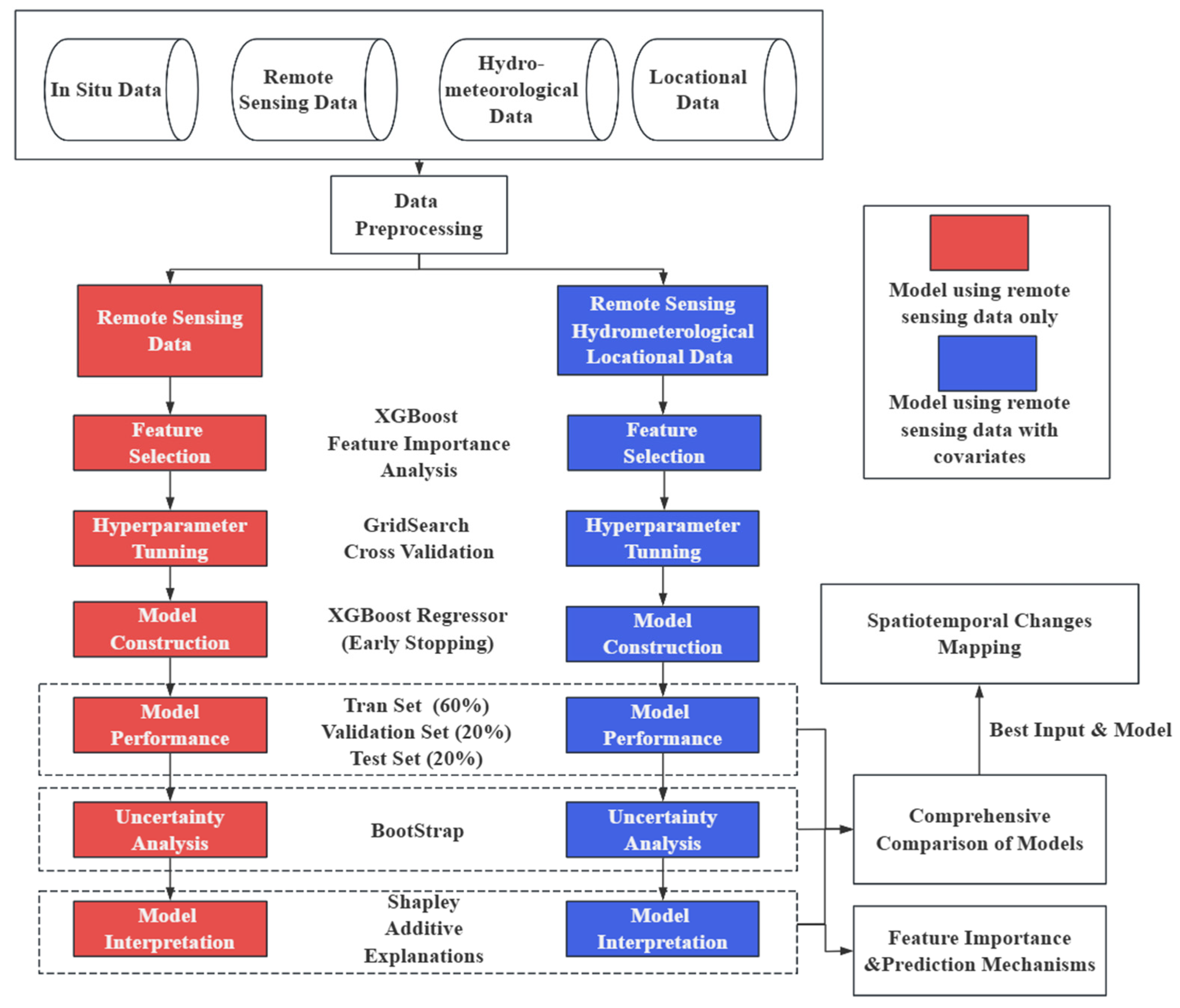

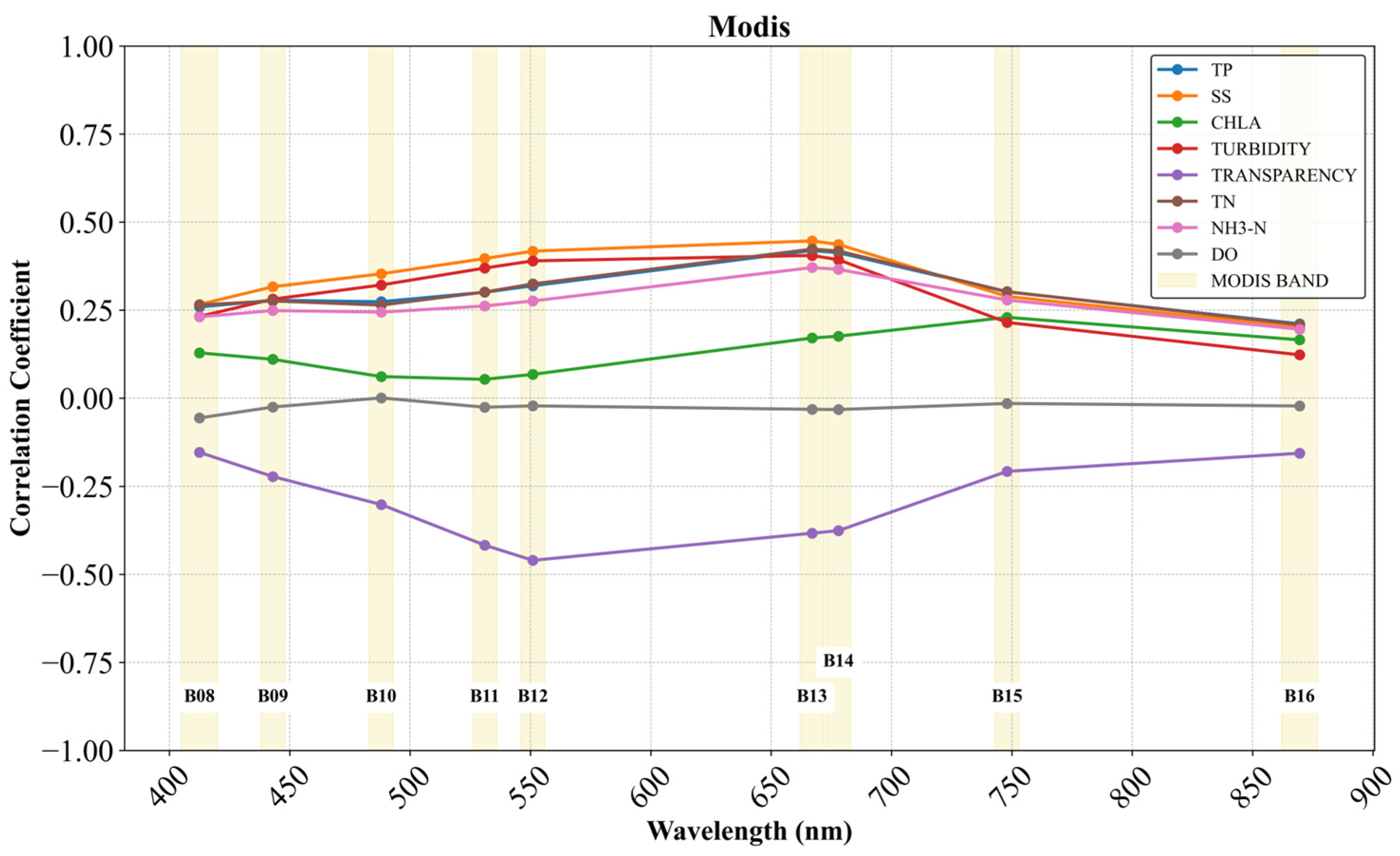
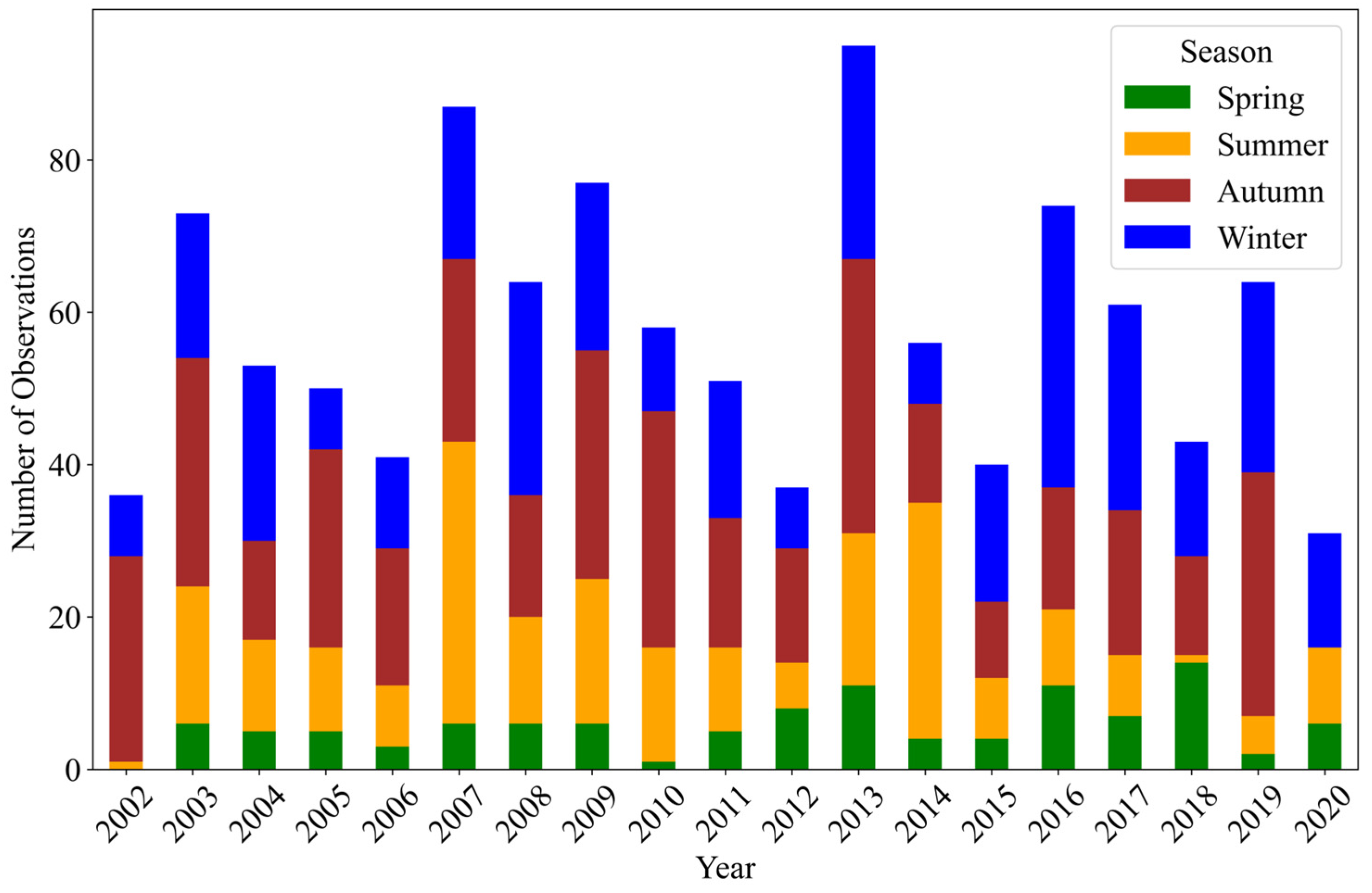

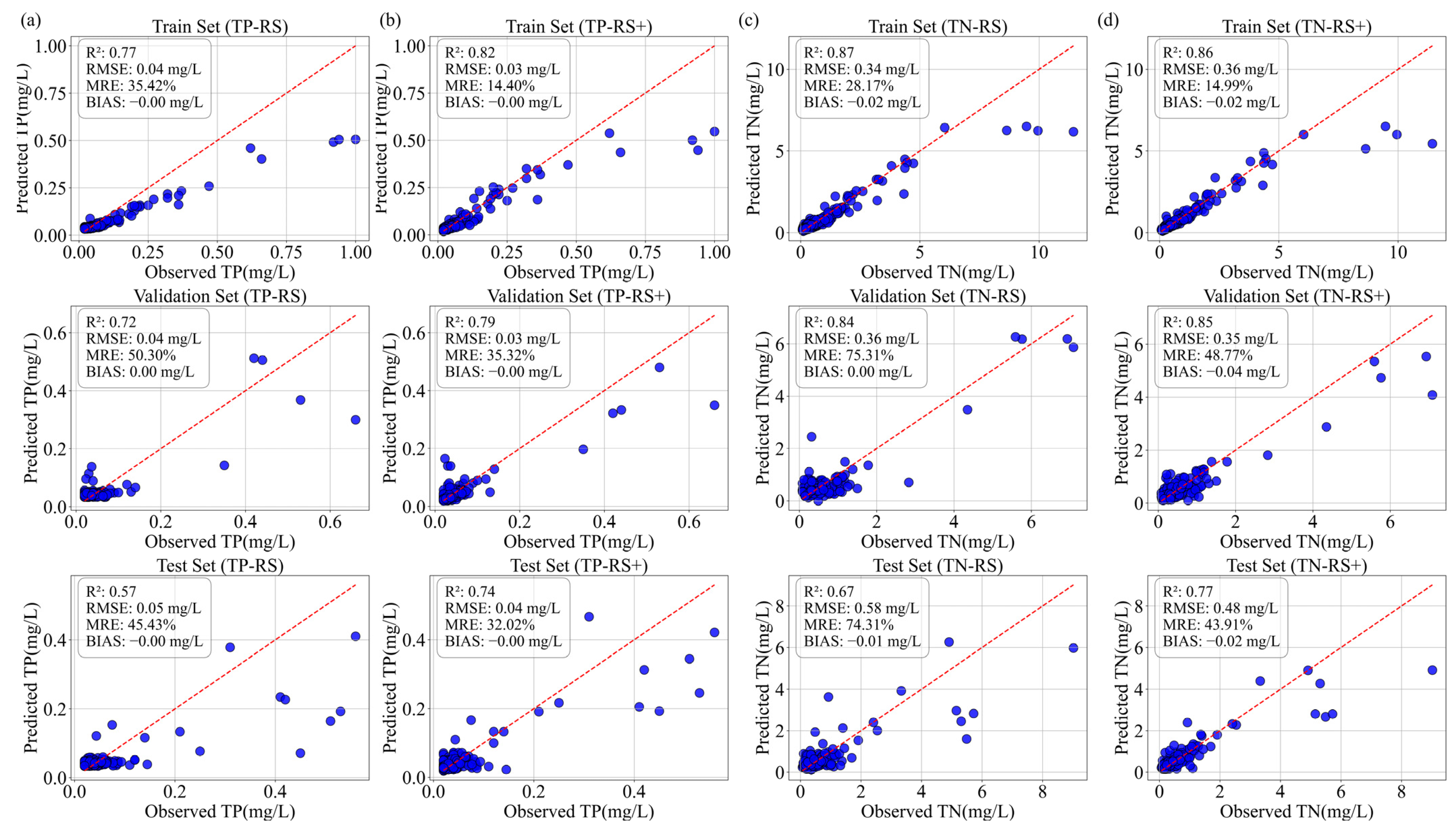

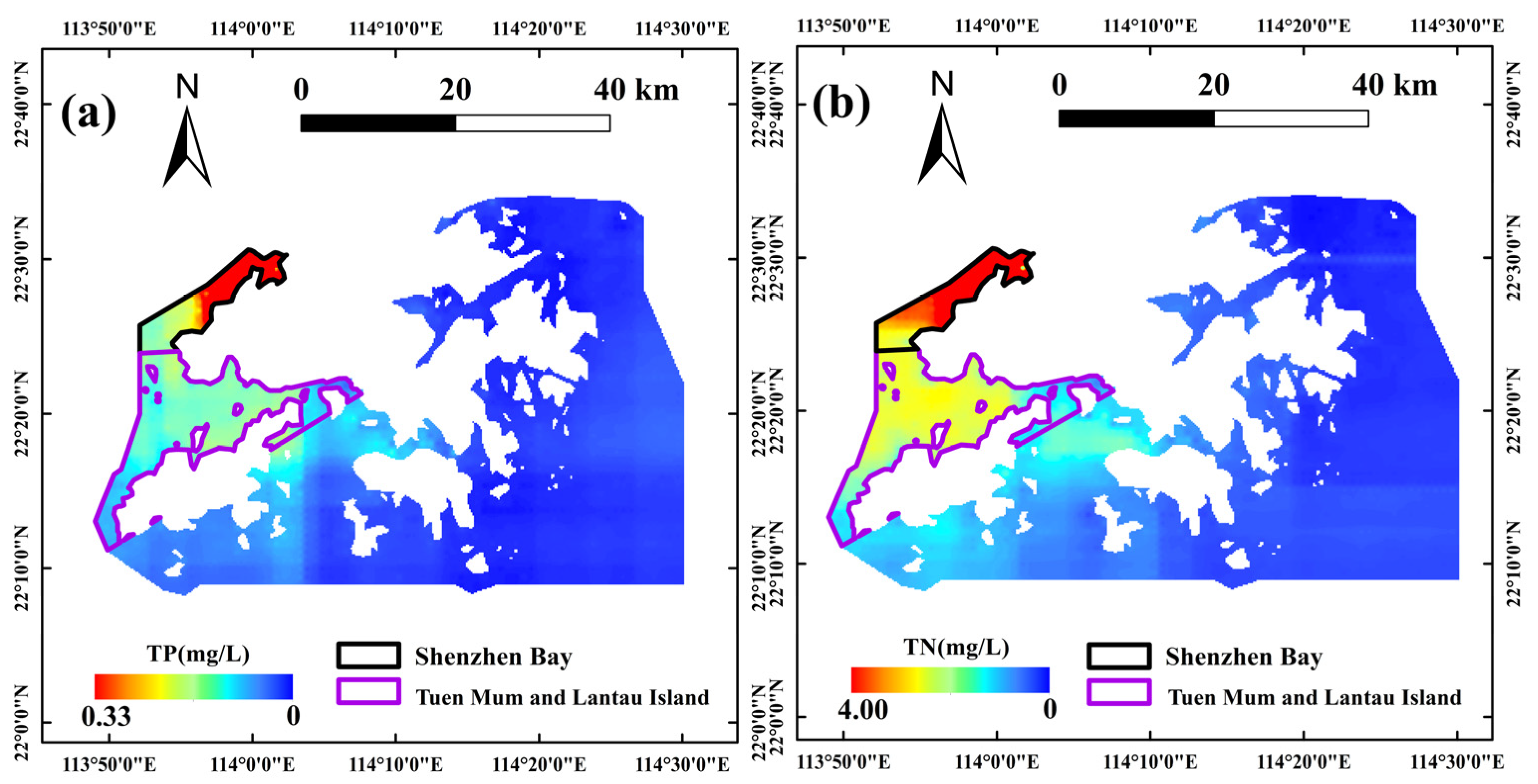

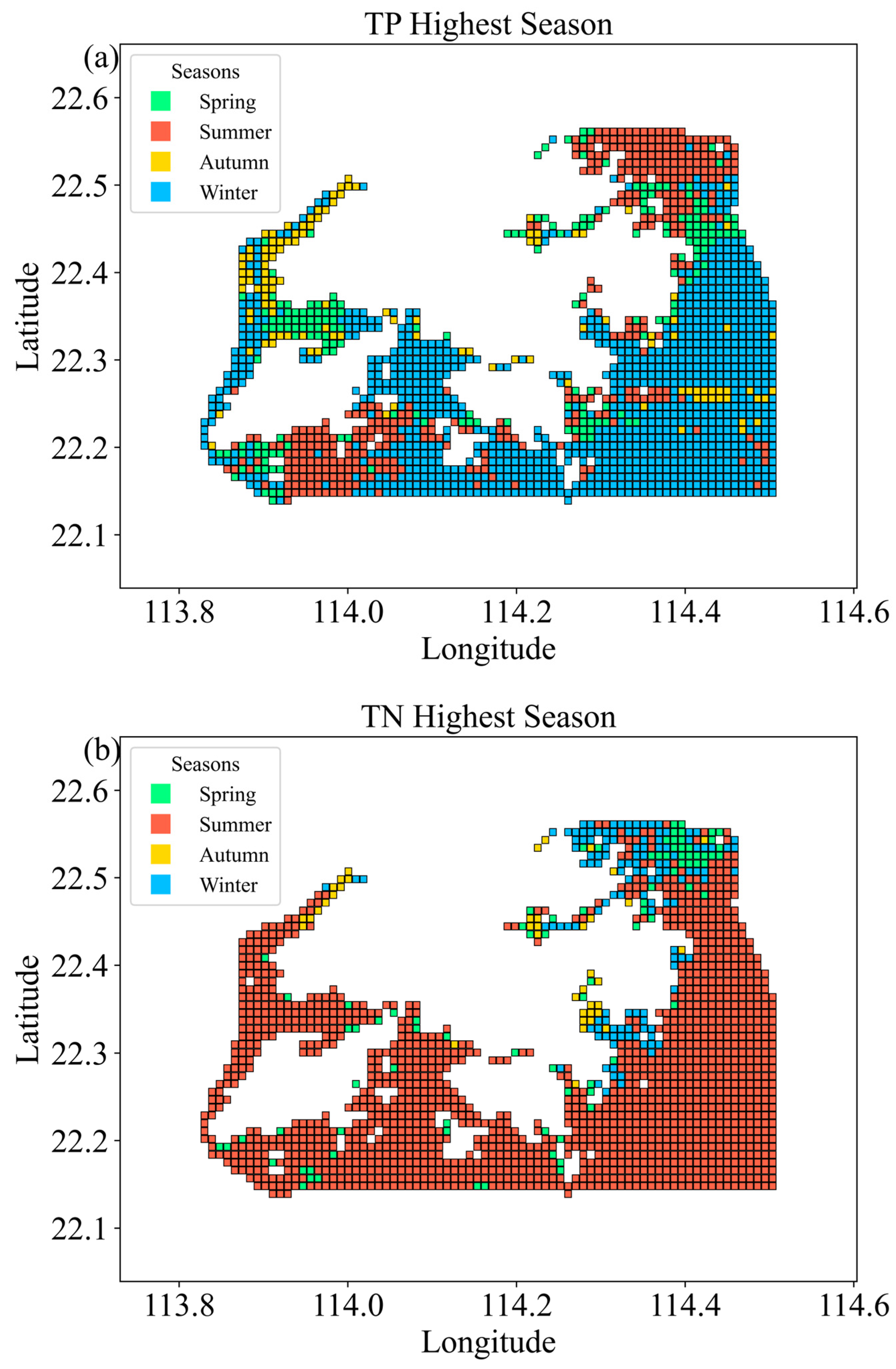
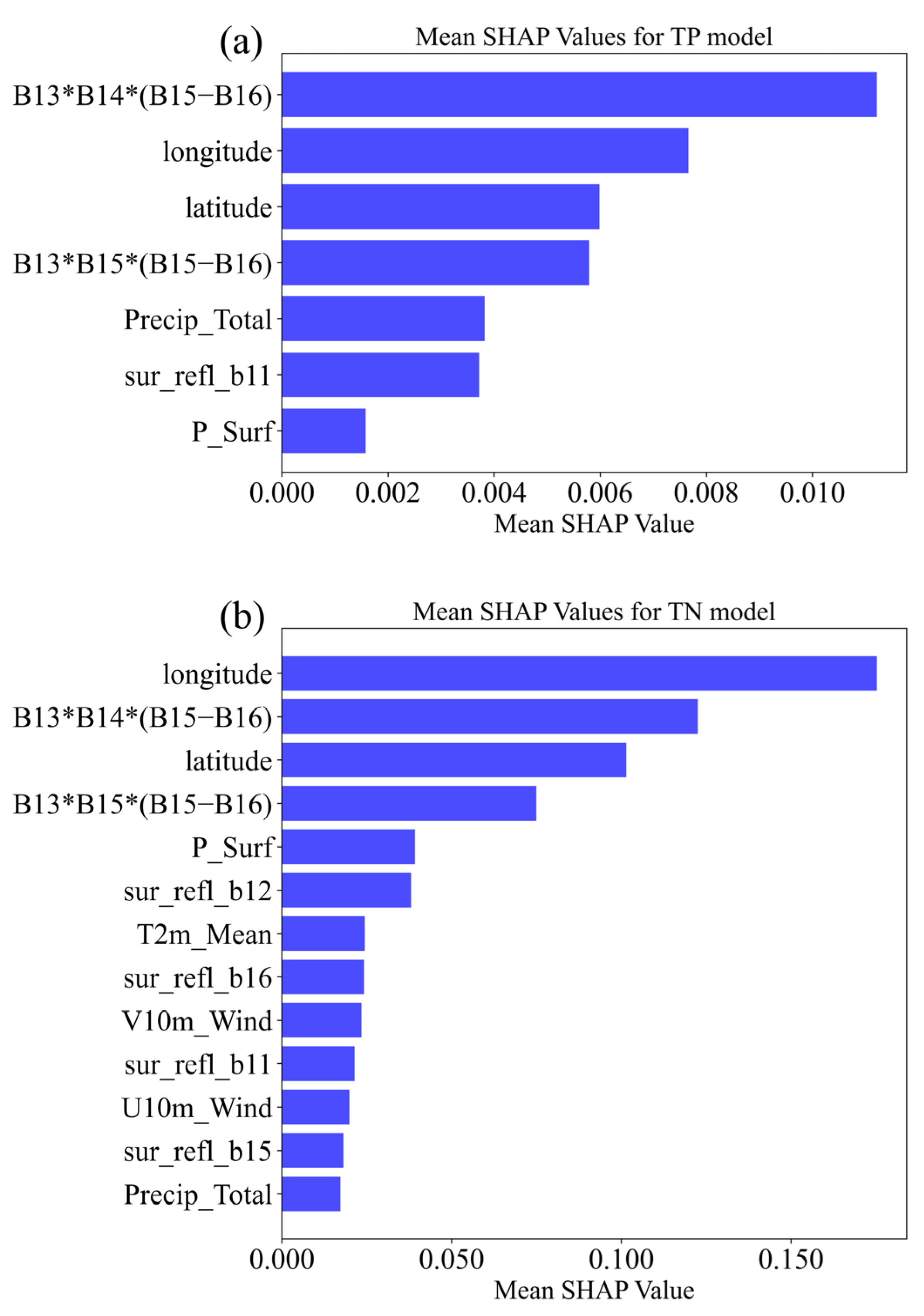
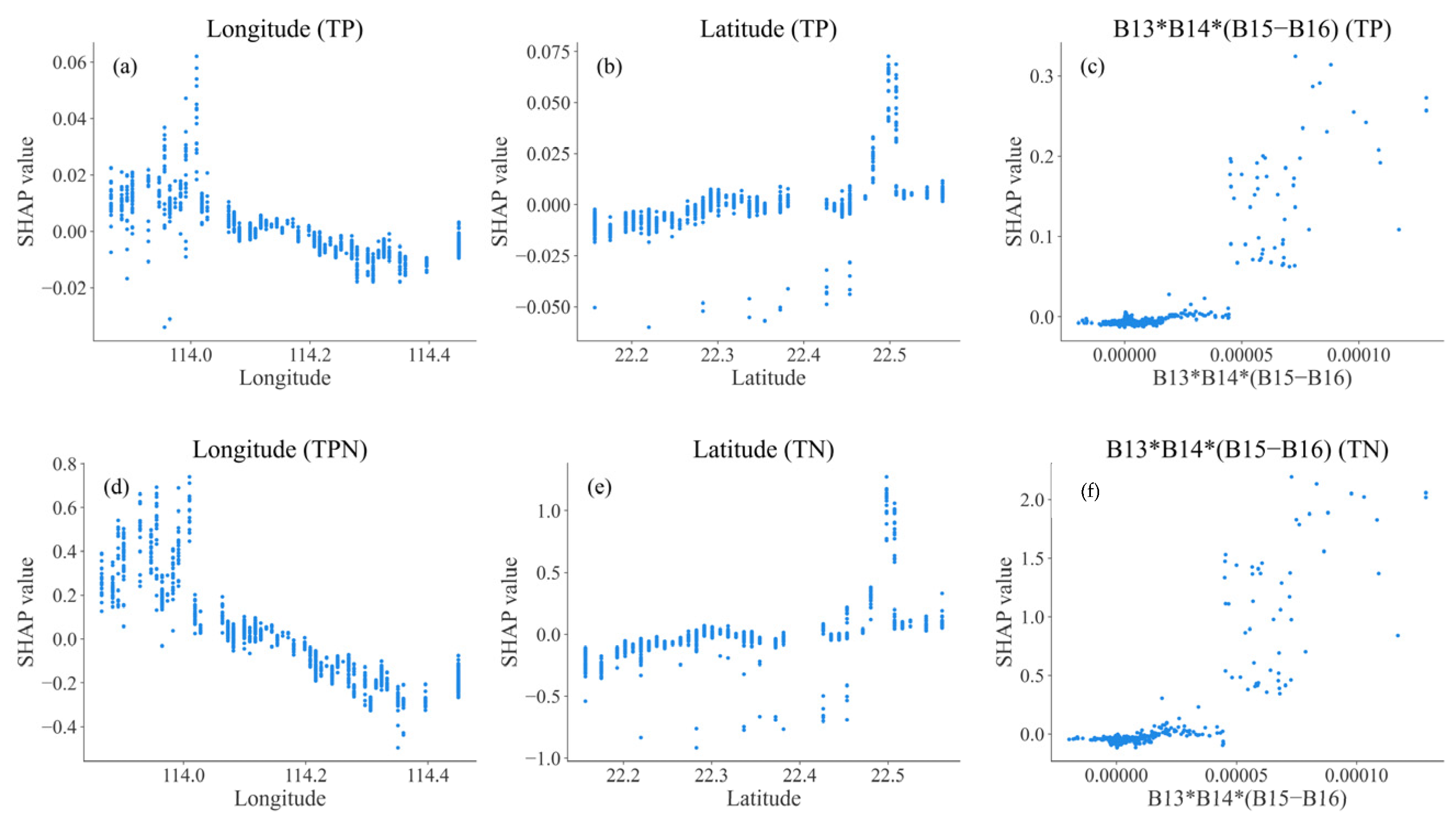
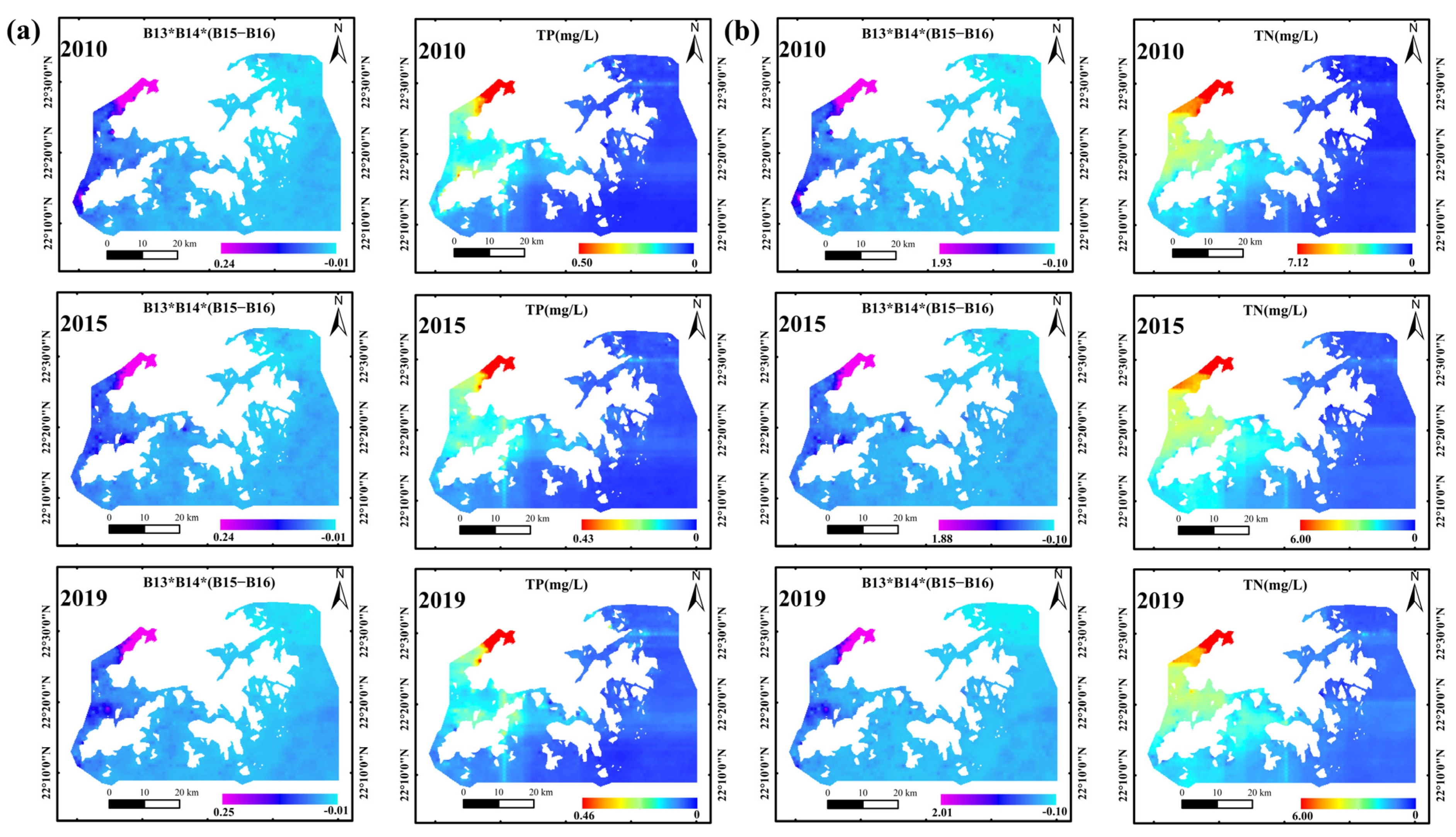


| Data | Data Source | Spatial Resolution | Temporal Resolution | Temporal Duration |
|---|---|---|---|---|
| In Situ Data | Hong Kong Environmental Protection Department (https://data.gov.hk/, accessed on 24 May 2024) | - | Monthly | 1986–2022 |
| Remote Sensing Data | MODIS (https://earthengine.google.com/, accessed on 24 May 2024) | 1000 m | Daily | 4 July 2002–25 February 2023 |
| Hydrometeorological Data | ERA5 (https://earthengine.google.com/, accessed on 24 May 2024) | 27,830 m | Daily | 2 January 1979–9 July 2020 |
| Parameter | Unit | Mean | Std | Min | Median | Max |
|---|---|---|---|---|---|---|
| TP a | mg/L | 0.05 | 0.08 | 0.02 | 0.04 | 1.30 |
| TN b | mg/L | 0.61 | 0.82 | 0.05 | 0.42 | 15.02 |
| NH3-N c | mg/L | 0.16 | 0.53 | 0.01 | 0.06 | 10.00 |
| SS d | mg/L | 7.28 | 11.17 | 0.50 | 4.60 | 360.00 |
| DO e | mg/L | 6.07 | 1.46 | 0.10 | 6.10 | 16.10 |
| Chl-a f | μg/L | 4.26 | 7.51 | 0.20 | 2.05 | 260.00 |
| Turbidity | NTU | 7.83 | 12.08 | 0.10 | 5.30 | 744.73 |
| Transparency | m | 2.55 | 1.17 | 0.10 | 2.50 | 34.00 |
| Chl-a c | DO d | SS e | Transparency | Turbidity | |
|---|---|---|---|---|---|
| TP a | 0.48 | −0.06 | 0.66 | −0.31 | 0.62 |
| TN b | 0.54 | −0.04 | 0.63 | 0.34 | 0.59 |
| Band Combination | TP | TN | |
|---|---|---|---|
| MODIS | B13*B14*(B15–B16) | 0.66 | 0.66 |
| B13*B15*(B15–B16) | 0.66 | 0.67 |
| Acronym | Variable Explanation | Units | Min | Max |
|---|---|---|---|---|
| T2m_Mean | Mean air temperature at 2 m height | K | 276.42 | 305.80 |
| T2m_Min | Minimum air temperature at 2 m height | K | 275.06 | 303.34 |
| T2m_Max | Maximum air temperature at 2 m height | K | 277.46 | 309.89 |
| T2m_Dew | Dewpoint temperature at 2 m height | K | 264.01 | 301.07 |
| Precip_Total | Total precipitation | m | 0.00 | 0.02 |
| P_Surf | Surface pressure | Pa | 97,967.06 | 103,511.82 |
| P_Msl | Mean sea level pressure | Pa | 98,893.12 | 103,644.31 |
| U10m_Wind | Average wind speed in the east–west direction at 10 m height | m/s | −12.84 | 8.62 |
| V10m_Wind | Average wind speed in the north–south direction at 10 m height | m/s | −11.66 | 10.67 |
| WQP | Reference | Input | Method | Train Set R2 | Test Set R2 |
|---|---|---|---|---|---|
| TN | Li et al. [14] | Landsat5, 8 | BPNN | 0.93 | 0.67 |
| TP | Li et al. [14] | Landsat5, 8 | BPNN | 0.85 | 0.63 |
| TSS | Liu et al. [11] | Landsat5, 8 | XGBoost | 0.93 | 0.68 |
| Chl-a | Liu et al. [11] | Landsat5, 8 | XGBoost | 0.99 | 0.59 |
| Chl-a | Wang et al. [52] | Sentinel2 | SAEO-BP | 0.92 | 0.73 |
Disclaimer/Publisher’s Note: The statements, opinions and data contained in all publications are solely those of the individual author(s) and contributor(s) and not of MDPI and/or the editor(s). MDPI and/or the editor(s) disclaim responsibility for any injury to people or property resulting from any ideas, methods, instructions or products referred to in the content. |
© 2024 by the authors. Licensee MDPI, Basel, Switzerland. This article is an open access article distributed under the terms and conditions of the Creative Commons Attribution (CC BY) license (https://creativecommons.org/licenses/by/4.0/).
Share and Cite
Zhang, Z.; Li, C.; Yang, P.; Xu, Z.; Yao, L.; Wang, Q.; Chen, G.; Tan, Q. Enhancing Remote Sensing Water Quality Inversion through Integration of Multisource Spatial Covariates: A Case Study of Hong Kong’s Coastal Nutrient Concentrations. Remote Sens. 2024, 16, 3337. https://doi.org/10.3390/rs16173337
Zhang Z, Li C, Yang P, Xu Z, Yao L, Wang Q, Chen G, Tan Q. Enhancing Remote Sensing Water Quality Inversion through Integration of Multisource Spatial Covariates: A Case Study of Hong Kong’s Coastal Nutrient Concentrations. Remote Sensing. 2024; 16(17):3337. https://doi.org/10.3390/rs16173337
Chicago/Turabian StyleZhang, Zewei, Cangbai Li, Pan Yang, Zhihao Xu, Linlin Yao, Qi Wang, Guojun Chen, and Qian Tan. 2024. "Enhancing Remote Sensing Water Quality Inversion through Integration of Multisource Spatial Covariates: A Case Study of Hong Kong’s Coastal Nutrient Concentrations" Remote Sensing 16, no. 17: 3337. https://doi.org/10.3390/rs16173337





